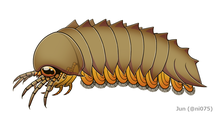Chelicerata
The subphylum Chelicerata (from Neo-Latin, from French chélicère, from Ancient Greek χηλή (khēlḗ) 'claw, chela' and κέρας (kéras) 'horn')[1] constitutes one of the major subdivisions of the phylum Arthropoda.The group has the open circulatory system typical of arthropods, in which a tube-like heart pumps blood through the hemocoel, which is the major body cavity.In general, the ganglia of living chelicerates' central nervous systems fuse into large masses in the cephalothorax, but there are wide variations and this fusion is very limited in the Mesothelae, which are regarded as the oldest and most basal group of spiders.To conserve water, air-breathing chelicerates excrete waste as solids that are removed from their blood by Malpighian tubules, structures that also evolved independently in insects.Although there is considerable agreement about the relationships between most chelicerate sub-groups, the inclusion of the Pycnogonida in this taxon has been questioned, and the exact position of scorpions is still controversial, though they were long considered the most basal of the arachnids.It was previously thought that chelicerates had lost the antennae-bearing somite 1,[14] but later investigations reveal that it is retained and corresponds to a pair of chelicerae or chelifores,[15] small appendages that often form pincers.[17][10] Like all arthropods, chelicerates' bodies and appendages are covered with a tough cuticle made mainly of chitin and chemically hardened proteins.[16] The relative sizes of chelicerae vary widely: those of some fossil eurypterids and modern harvestmen form large claws that extended ahead of the body,[19] while scorpions' are tiny pincers that are used in feeding and project only slightly in front of the head.All the Acari have a retractable feeding assembly that consists of the chelicerae, pedipalps and parts of the exoskeleton, and which forms a preoral cavity for pre-processing food.The tubules filter wastes out of the blood and dump them into the hindgut as solids, a system that has evolved independently in insects and several groups of arachnids.[23] Chelicerate nervous systems are based on the standard arthropod model of a pair of nerve cords, each with a ganglion per segment, and a brain formed by fusion of the ganglia just behind the mouth with those ahead of it.Various touch and vibration sensors, mostly bristles called setae, respond to different levels of force, from strong contact to very weak air currents.[17] At the other extreme, jumping spiders have a very wide field of vision,[16] and their main eyes are ten times as acute as those of dragonflies,[35] able to see in both colors and UV-light.[42][43][44][45] Female pseudoscorpions carry their eggs in a brood pouch on the belly, where the growing embryos feeds on a nutritive fluid provided by the mother during development, and are therefore matrotrophic.The Burgess shale animals like Sidneyia from about 505 million years ago have been classified as chelicerates, the latter because its appendages resemble those of the Xiphosura (horseshoe crabs).[49] Sanctacaris, member of the family Sanctacarididae from the Burgess Shale of Canada, represents the oldest occurrence of a confirmed chelicerate, Middle Cambrian in age.[54] The oldest known arachnid is the trigonotarbid Palaeotarbus jerami, from about 420 million years ago in the Silurian period, and had a triangular cephalothorax and segmented abdomen, as well as eight legs and a pair of pedipalps.[63] Hexapoda Crustacea Myriapoda Chelicerata Chelicerata Crustacea Trilobita Hexapoda Myriapoda The "traditional" view of the arthropod "family tree" shows chelicerates as less closely related to the other major living groups (crustaceans; hexapods, which includes insects; and myriapods, which includes centipedes and millipedes) than these other groups are to each other.An attempt in 2002 to combine analysis of DNA features of modern chelicerates and anatomical features of modern and fossil ones produced credible results for many lower-level groups, but its results for the high-level relationships between major sub-groups of chelicerates were unstable, in other words minor changes in the inputs caused significant changes in the outputs of the computer program used (POY).Some early fossils such as the Late Silurian Proscorpius have been classified by paleontologists as scorpions, but described as wholly aquatic as they had gills rather than book lungs or tracheae.Eurypterids were recovered as closely related to arachnids instead of xiphosurans, forming the group Sclerophorata within the clade Dekatriata (composed of sclerophorates and chasmataspidids).This work suggested it is possible that Dekatriata is synonymous with Sclerophorata as the reproductive system, the primary defining feature of sclerophorates, has not been thoroughly studied in chasmataspidids.[13][27][82] In the past, Native Americans ate the flesh of horseshoe crabs, and used the tail spines as spear tips and the shells to bail water out of their canoes.Horseshoe crab blood contains a clotting agent, limulus amebocyte lysate, which is used to test antibiotics and kidney machines to ensure that they are free of dangerous bacteria, and to detect spinal meningitis and some cancers.[116] Mites cause several forms of allergic diseases, including hay fever, asthma and eczema, and they aggravate atopic dermatitis.





Middle CambrianPresentPreꞒFortunianLimulus polyphemusEurypterus remipesAraneus diadematusButhus occitanusTrombidium holosericeumScientific classificationEukaryotaAnimaliaArthropodaArachnomorphaHeymonsHabeliidaMollisoniidaMegacheiraPycnogonidaOffacolidaeWeinberginaProsomapodaSynonymsNeo-LatinFrenchAncient Greeksea spidershorseshoe crabsarachnidsharvestmenscorpionsspiderssolifugeseurypteridschasmataspididsMandibulataCambrianstem-groupMollisoniaxiphosuranspycnogonidsarthropodssegmentedcuticlechitinproteinsbody plantagmataprosomaopisthosomacheliceraeappendagesopen circulatory systemhemocoelbook lungstracheaegangliacentral nervous systemsMesothelaebristlesparasitismherbivoryscavengingeating decaying organic matterpedipalpsenzymesMalpighian tubulesevolved independentlyinsectsexternal fertilizationcourtshipevolutionarywhip scorpionsshorttailed whipscorpionsbeetle mitescancererectile dysfunctionbacteriaallergieslivestockTrilobitomorphaCrustaceaTracheatanephridiaAntennaCheliceraPedipalpChilariumMandibleMaxillaembryocoelomcephalothoraxabdomenlabrumpincerscompound eyesocellitelsonscorpioneurypteridspinneretssyringesstomachMalphigian tubulesSpinneretTracheaBook lungNerve cordarteriescirculatory systemsbook gillsOnychopterellaOrdovicianpredatorsherbivorenectarpollenparasitesscavengerexoskeletonnitrogenousammoniaindependentlynerve cordsganglion